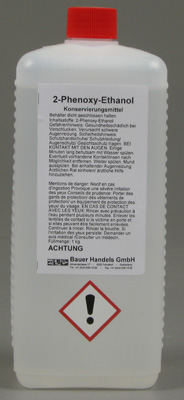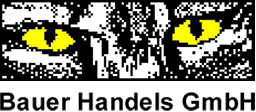Preservative
2-PHENOXY-ETHANOL
Small mammals, lizards, snakes, crabs, birds etc. can be optimally preserved with 2-phenoxy ethanol. Objects preserved in this way provide an ideal starting point for further examinations or for further mounting, as the bodies do not become hard.
Preparation STANDARD FIXING SOLUTION-BNM:.
Inject solution well into all soft tissues (but not too much so that no bloating occurs). Place the injected carcasses in an appropriately sized, tightly sealed jar (Plexiglas is unsuitable) with a sufficient amount of fixative solution. Leave the objects in the standard fixation solution BNM for approx. 10 days until complete tissue fixation is achieved. Then transfer the object to the STANDARD CONSERVATION SOLUTION-BNM.
Preparation STANDARD CONSERVATION SOLUTION-BNM:
STANDARD CONSERVATION SOLUTION-BNM is only suitable as a storage medium if a protein precipitating preservation has taken place beforehand (e.g. with STANDARD CONSERVATION SOLUTION-BNM or with formaldehyde). Freezing of the objects must be avoided at all costs, otherwise the objects will show the same properties as formaldehyde-fixed objects.
- Boil water
- Add 2% 2-phenoxy-ethanol = 20g per litre
- Add 0.7% sodium bicarbonate = 7g per litre
- Add 1% sodium chloride = 10g per litre
- Cover the solution and allow to cool completely.
- Add 2% formaldehyde 36% = 20g per litre
Inject solution well into all soft tissues (but not too much so that no bloating occurs). Place the injected carcasses in an appropriately sized, tightly sealed jar (Plexiglas is unsuitable) with a sufficient amount of fixative solution. Leave the objects in the standard fixation solution BNM for approx. 10 days until complete tissue fixation is achieved. Then transfer the object to the STANDARD CONSERVATION SOLUTION-BNM.
Preparation STANDARD CONSERVATION SOLUTION-BNM:
- Boil water.
- Add 2% 2-phenoxy-ethanol = 20g per litre
- Add 0.7% sodium bicarbonate= 7g per litre
- Add 1% sodium chloride = 10g per litre
- Cover solution and allow to cool completely
STANDARD CONSERVATION SOLUTION-BNM is only suitable as a storage medium if a protein precipitating preservation has taken place beforehand (e.g. with STANDARD CONSERVATION SOLUTION-BNM or with formaldehyde). Freezing of the objects must be avoided at all costs, otherwise the objects will show the same properties as formaldehyde-fixed objects.




Safety:
H302 Harmful if swallowed.
H319 Causes serious eye irritation.
H319 Causes serious eye irritation.
Note:
Objects preserved with 2-phenoxyethanol must never be deep-frozen. Deep-frozen objects behave like formaldehyde-fixed objects afterwards.
All prices plus VAT and shipping costs

